Created by Faststats Log File
Analyzer on February 20, 2025 08:29 AM. |
General Statistics |
The General Statistics Report gives you a quick overview of your web site traffic. Of particular interest are the "Hits", "Total Visiting Users", and "Hits on Pages" fields.
| Item | Value |
|---|---|
| Hits | 3867 |
| Total Data Transferred | 2.27 gigabytes |
| Total Visiting Users | 1835 |
| Time Period | February 13, 2025, 12:01:51 AM to February 19, 2025, 11:55:1... |
| Average Hits per User | 2.11 |
| Average Users per Day | 262.14 |
| Average Data Transferred per Day | 331.78 megabytes |
| Hits cached by Client | 51 (1.32%) |
| Report generated on | February 20, 2025 at 09:29:53 AM |
| Incomplete downloads/file requests | 37 (0.96%) |
| Log spans a period of | 7 days |
| Total failed requests | 974 (25.19%) |
| Average Data Transferred per User | 1.27 megabytes |
| Average Hits per Day | 552.43 |
| Average Data Transferred per Hit | 615.00 kilobytes |
| Hits on Pages | 918 |
| Hits on Files | 1182 |
| Hits for Graphics | 642 |
Need to know where your visitors are? What kind of systems they are using? Your visitor stats can give you that information. Analyzer is up-to-date at recognizing the most recent browsers and operating systems. You need to make sure that your website is viewable best by the technology your visitors are using. You can use visitor reports as a checklist and priority list to make sure your visitors see what you think they are seeing.
Visitor Information: Domain Name |
The Visiting Domain Name Report displays the domains that most frequently accessed your web site. Domains are servers on the Internet such as AOL or a local Internet Service Provider and are uniquely identified by a number called an IP address, such as 208.219.77.29. Those numbers are translated for people into names, by the Internet Domain Name System (DNS).
| Domain Name | Hits | Bandwidth |
|---|---|---|
| 216.244.66.234 | 344 | 376.84 megabytes |
| 149.130.215.43 | 245 | 36.57 kilobytes |
| hn.kd.ny.adsl | 104 | 247.45 kilobytes |
| crawl-66-249-66-198.googlebot.com | 96 | 62.09 megabytes |
| crawl-66-249-66-199.googlebot.com | 96 | 402.12 megabytes |
| 174.160.191.64 | 77 | 21.43 megabytes |
| crawl-66-249-66-200.googlebot.com | 63 | 68.50 megabytes |
| 156.59.198.136 | 62 | 959.19 kilobytes |
| 156.59.198.135 | 62 | 44.94 kilobytes |
| 103.153.183.204 | 50 | 30.32 kilobytes |
| fulltextrobot-77-75-76-171.seznam.cz | 40 | 23.65 megabytes |
| connected-by.global-layer.com | 37 | 2.98 kilobytes |
| 45.148.10.90 | 25 | 37.22 kilobytes |
| 195.211.191.110 | 24 | 0.00 bytes |
| ec2-44-213-62-147.compute-1.amazonaws.com | 21 | 30.48 kilobytes |
| 152.42.217.137 | 21 | 30.48 kilobytes |
| ec2-35-172-136-107.compute-1.amazonaws.com | 20 | 0.00 bytes |
| m1.hocking.beget.com | 20 | 199.14 kilobytes |
| 45.32.95.77.vultrusercontent.com | 20 | 0.00 bytes |
| d559d155e9.scan.leakix.org | 19 | 3.86 kilobytes |
| a4ac419f3c.scan.leakix.org | 19 | 22.89 kilobytes |
| f090494790.scan.leakix.org | 19 | 22.89 kilobytes |
| eab9c05722.scan.leakix.org | 19 | 3.86 kilobytes |
| crawl-66-249-66-32.googlebot.com | 18 | 3.73 kilobytes |
| fulltextrobot-77-75-76-172.seznam.cz | 18 | 17.12 kilobytes |
| crawl-66-249-66-34.googlebot.com | 17 | 3.47 kilobytes |
| ip24-251-155-119.ph.ph.cox.net | 17 | 22.02 megabytes |
| crawler-51.nicecrawler.com | 17 | 93.40 kilobytes |
| ec2-52-5-186-238.compute-1.amazonaws.com | 16 | 92.47 kilobytes |
| 173-255-251-12.ip.linodeusercontent.com | 16 | 181.96 kilobytes |
| 195.78.54.43 | 16 | 10.56 kilobytes |
| 23-239-26-187.ip.linodeusercontent.com | 16 | 181.96 kilobytes |
| static.200.250.119.168.clients.your-server.de | 16 | 199.63 kilobytes |
| crawl-66-249-66-203.googlebot.com | 15 | 29.56 megabytes |
| 4.155.13.225 | 15 | 398.69 megabytes |
| crawl-66-249-66-201.googlebot.com | 15 | 2.22 megabytes |
| 53.18.72.34.bc.googleusercontent.com | 14 | 196.47 kilobytes |
| crawl-66-249-66-202.googlebot.com | 14 | 61.17 megabytes |
| 234.212.134.34.bc.googleusercontent.com | 14 | 196.47 kilobytes |
| crawl-66-249-66-38.googlebot.com | 14 | 2.84 kilobytes |
| 112.206.138.69.pldt.net | 14 | 196.47 kilobytes |
| ec2-71-132-12-115.cn-north-1.compute.amazonaws.com.cn | 13 | 83.91 kilobytes |
| ec2-140-179-71-143.cn-north-1.compute.amazonaws.com.cn | 13 | 83.91 kilobytes |
| 20.171.207.119 | 13 | 15.33 kilobytes |
| hostedby.privatelayer.com | 13 | 0.00 bytes |
| ninja-crawler85.blex.seranking.com | 13 | 12.63 kilobytes |
| 20.171.207.213 | 13 | 15.01 megabytes |
| ec2-18-236-105-104.us-west-2.compute.amazonaws.com | 13 | 83.91 kilobytes |
| ec2-34-211-117-137.us-west-2.compute.amazonaws.com | 12 | 18.98 kilobytes |
| m12627.contaboserver.net | 12 | 871.00 bytes |
| crawl-vykctc.mj12bot.com | 12 | 13.01 kilobytes |
| crawl-66-249-66-33.googlebot.com | 12 | 2.44 kilobytes |
| petalbot-114-119-138-27.petalsearch.com | 11 | 45.32 megabytes |
| crawl-66-249-66-37.googlebot.com | 11 | 2.21 kilobytes |
| 119.dallas-15rh16rt.tx.dial-access.att.net | 11 | 79.33 kilobytes |
| 138.68.235.46 | 10 | 19.25 kilobytes |
| 27.115.124.104 | 10 | 14.30 kilobytes |
| msnbot-40-77-167-184.search.msn.com | 9 | 1.07 kilobytes |
| 27.115.124.97 | 9 | 254.37 kilobytes |
| 196.251.117.232 | 9 | 60.42 kilobytes |
| 145.239.10.137 | 8 | 2.84 kilobytes |
| crawl-lrsstc.mj12bot.com | 8 | 9.55 kilobytes |
| 156.120.45.34.bc.googleusercontent.com | 8 | 422.00 bytes |
| 200.156.38.34.bc.googleusercontent.com | 8 | 13.00 kilobytes |
| 47.82.38.159 | 8 | 27.83 kilobytes |
| 75.51.79.34.bc.googleusercontent.com | 8 | 13.00 kilobytes |
| msnbot-157-55-39-225.search.msn.com | 8 | 1008.00 bytes |
| 125.144.126.34.bc.googleusercontent.com | 8 | 422.00 bytes |
| 27.115.124.3 | 7 | 16.23 kilobytes |
| 20.171.207.26 | 7 | 3.20 megabytes |
| 64.71.179.42 | 7 | 4.08 megabytes |
| 101.36.114.222 | 7 | 1.76 kilobytes |
| 152.32.200.117 | 7 | 1.76 kilobytes |
| 4.227.36.62 | 7 | 588.00 bytes |
| msnbot-40-77-167-48.search.msn.com | 7 | 0.00 bytes |
| 124.236.100.56 | 7 | 9.67 kilobytes |
| linux11.r00tbase.de | 7 | 593.00 bytes |
| proxy-ca000-ext2.ahrefs.net | 7 | 9.81 kilobytes |
| msnbot-40-77-167-11.search.msn.com | 7 | 808.68 kilobytes |
| ns3004525.ip-188-165-232.eu | 7 | 593.00 bytes |
| 210.138.231.35.bc.googleusercontent.com | 6 | 422.00 bytes |
| 47.76.209.138 | 6 | 252.00 bytes |
| vmi2241711.contaboserver.net | 6 | 12.43 kilobytes |
| 194.5.82.59 | 6 | 5.96 kilobytes |
| 111.7.96.178 | 6 | 127.08 kilobytes |
| 4.227.36.119 | 6 | 840.00 bytes |
| bytespider-110-249-202-29.crawl.bytedance.com | 6 | 10.10 kilobytes |
| crawl-66-249-66-36.googlebot.com | 6 | 1.17 kilobytes |
| bytespider-111-225-148-28.crawl.bytedance.com | 6 | 8.56 kilobytes |
| 172-245-62-102-host.colocrossing.com | 6 | 655.00 bytes |
| 167.253.34.3 | 6 | 921.00 bytes |
| 47.76.220.119 | 6 | 252.00 bytes |
| 249.78.202.35.bc.googleusercontent.com | 6 | 422.00 bytes |
| 66.220.29.156 | 6 | 15.33 megabytes |
| crawl-xuxehn.mj12bot.com | 6 | 9.13 kilobytes |
| 18-97-14-89.crawl.commoncrawl.org | 6 | 19.84 megabytes |
| vmi2355009.contaboserver.net | 6 | 10.73 kilobytes |
| msnbot-40-77-167-6.search.msn.com | 6 | 9.89 kilobytes |
| dynamicip-94-181-187-69.pppoe.penza.ertelecom.ru | 5 | 1.12 kilobytes |
| msnbot-52-167-144-170.search.msn.com | 5 | 1.19 megabytes |
Visitor Information: Geographical Location |
This report displays information about the countries visitors to your site are located in. The geographical information comes from a database that we maintain on our server which associates countries with IP addresses. The database is not guaranteed to be accurate, but we do our best to keep it up to date. The geographic data is provided by http://ip-to-country.webhosting.info/.
There were no items in this report.
Visitor Information: Web Browsers |
The Browser Report tells you what web browsers visitors are using when they access your web site. Tip: use this report to determine whether the browsers visiting your web site support a specific web technology. For example, if most of your users use Netscape 4 or 6, or Internet Explorer 5, then it's safe to use an advanced feature like cascading style sheets.
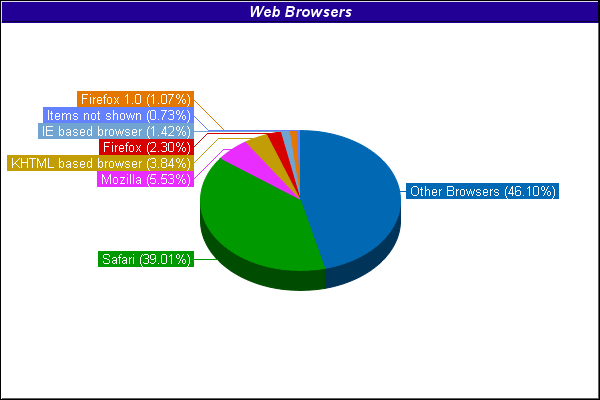
| Browser | Hits | Percentage |
|---|---|---|
| Opera 7 | 1 | 0.03% |
| Lynx 2 | 1 | 0.03% |
| Firefox 1.0 | 15 | 0.46% |
| Firefox | 61 | 1.86% |
| Konqueror | 1 | 0.03% |
| Safari 2 | 1 | 0.03% |
| Safari | 1688 | 51.43% |
| KHTML based browser | 76 | 2.32% |
| Gecko based browser | 2 | 0.06% |
| IE based browser | 5 | 0.15% |
| Mozilla | 578 | 17.61% |
| Other Browsers | 853 | 25.99% |
Visitor Information: Operating Systems |
The Visiting Operating Systems Report tells you what Operating System your visitors are using. Tip: use this report to determine if a web technology is appropriate. If 99% of your visitors use Windows, then you can focus on designing your site for Windows users, with Windows technology such as Active-X controls. But if a significant percentage of your visitors do not use Windows, it would be wise to use a platform independent language like Java.
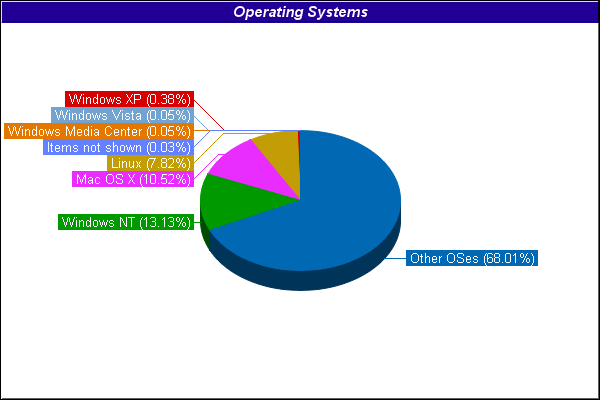
| Operating System | Hits | Percentage |
|---|---|---|
| Windows Media Center | 1 | 0.03% |
| Windows Vista | 4 | 0.12% |
| Windows XP | 2 | 0.06% |
| Windows Server 2003 | 1 | 0.03% |
| Windows NT | 542 | 16.51% |
| Mac OS X | 411 | 12.52% |
| Linux | 536 | 16.33% |
| Other OSes | 1785 | 54.39% |
Visitor Information: Search Engine Spiders |
Search Engine spiders are robots that traverse your website in order list it on Search Engines. This report shows a breakdown of which spiders have visited your site.
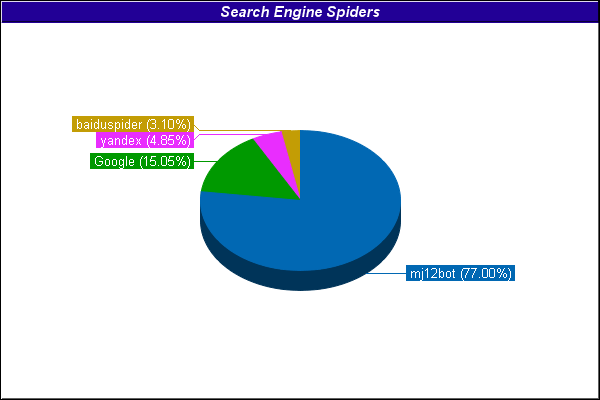
| Spider | Hits | Percentage |
|---|---|---|
| 363 | 62.05% | |
| baiduspider | 87 | 14.87% |
| mj12bot | 67 | 11.45% |
| yandex | 68 | 11.62% |
Visitor Information: Authenticated Users |
The authenticated users report shows you hits and sessions of a user who logged in to your site using http authentication. If the visitor did not log in, it will show up as "-".
| Username | Hits | Sessions | Bandwidth |
|---|---|---|---|
| - | 2004 | 337 | 2.27 gigabytes |
These great reports give you detailed information on how your visitors use your site. And all of them are available in the regular version of FastStats Analyzer! If you need great basic stats, check out what FastStats can do! * Detailed breakdown of pages, files, images, and directories pulled from your server. * Graphical and chart views of total hits, broken down into bandwidth, page views, and visitors per day. * Tracking of popular days and hours so that you can schedule necessary downtime most effectively. * Comprehensive summary of query string variables used on your pages, along with the values of those variables.
Page Type analysis measures hits and bandwidth in four categories. A request can be either a * Page: General webpages displayed in a browser. * Image: GIF, JPEG, PNG and other image format files. * File: EXE, PDF, ZIP and other downloadable content. * Misc.: Javascript, CSS and other supporting files.
Access Statistics: Page Types: Page Types (Hits) |
This report shows a breakdown of the page type by the number of hits to your site.
.gif)
| Page Type | Hits | Percentage |
|---|---|---|
| Files | 1182 | 43.11% |
| Images | 350 | 12.76% |
| Pages | 918 | 33.48% |
| Misc. Web | 292 | 10.65% |
Access Statistics: Page Types: Page Types (Bandwidth) |
This report shows a breakdown of the page type by the amount of bandwith used by each type.
.gif)
| Page Type | Bandwidth | Percentage |
|---|---|---|
| Files | 2.21 gigabytes | 97.57% |
| Images | 52.07 megabytes | 2.24% |
| Pages | 2.57 megabytes | 0.11% |
| Misc. Web | 1.69 megabytes | 0.07% |
Most Popular Resource analysis shows most frequently occuring requests broken down by type, but also includes summary information across all types and directories.
Access Statistics: Most Popular Resources: Most Requested Resources |
This report displays the most requested resources on your web site. Resources include Pages, Files, Images and Misc. Web items served on your website.
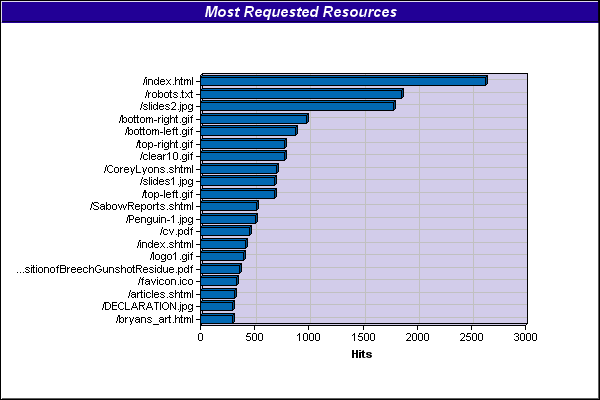
Access Statistics: Most Popular Resources: Most Requested Pages |
This report shows the most requested pages on your web site. Pages are defined in the file extenstions section under Global Options.
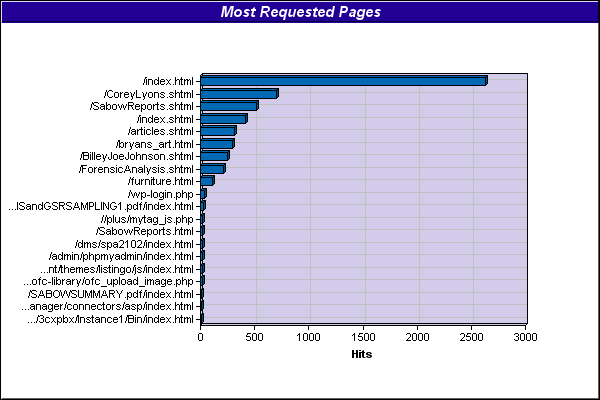
Access Statistics: Most Popular Resources: Most Requested Files |
This report shows the most requested files on your web site. 'Files' are defined as accesses that are not Graphics, Pages or Misc. Web, such as an application with the extension .exe. Tip: Incomplete Requests are requests that were canceled in the middle of a transfer (i.e. the user got tired of waiting for the file to download and clicked the Stop button in their browser). If you have a large number of incomplete requests for a file, it's a good idea to try to reduce the size of that file or check your web server's performance.
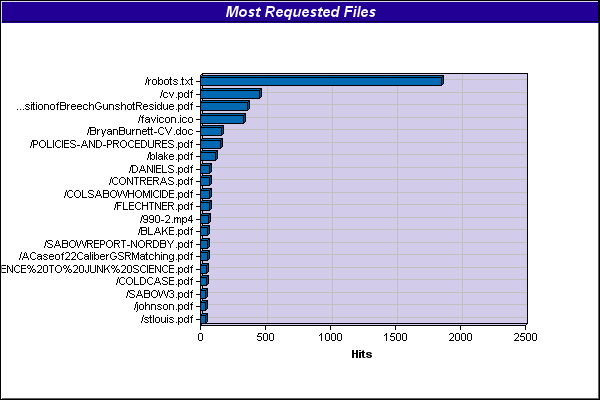
Access Statistics: Most Popular Resources: Most Popular Images |
This report details the most requested graphics on your web site. Graphics are defined on the file extensions tab under global options. Tip: if you have a large number of incomplete requests for an image, it's a good idea to try to reduce the size of that graphic or check your web server's performance.
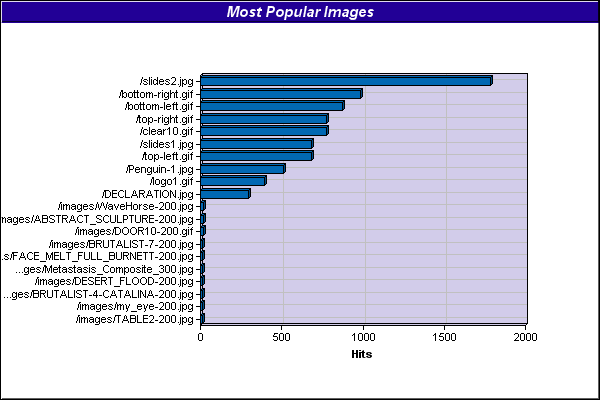
Access Statistics: Most Popular Resources: Most Popular Misc. Web |
This report details the most requested misc. web files on your web site. Misc. Web files types are defined in the global options under file extensions.
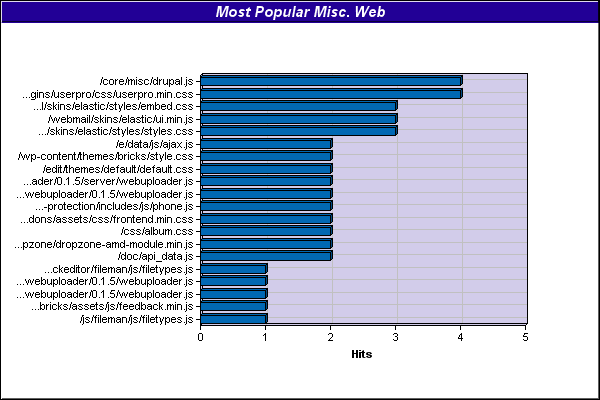
| Filename | Hits | Bandwidth |
|---|---|---|
| /owl-carousel/owl.carousel.js | 52 | 574.48 kilobytes |
| /css/font-awesome.min.css | 44 | 287.81 kilobytes |
| /css/style.css | 43 | 229.68 kilobytes |
| /css/menu.css | 42 | 96.40 kilobytes |
| /css/zerogrid.css | 42 | 43.52 kilobytes |
| /owl-carousel/owl.carousel.css | 40 | 23.40 kilobytes |
| /js/image-zoom.js | 5 | 4.45 kilobytes |
| /media/system/js/core.js | 5 | 1.02 kilobytes |
| /wp-includes/js/jquery/jquery.js | 4 | 856.00 bytes |
| /css/image-zoom.css | 3 | 1014.00 bytes |
| /core/misc/drupal.js | 2 | 0.00 bytes |
| /webmail/skins/elastic/styles/embed.css | 1 | 2.92 kilobytes |
| /webmail/program/js/jstz.min.js | 1 | 13.51 kilobytes |
| /webmail/plugins/jqueryui/js/i18n/jquery.ui.datepicker-fr.js | 1 | 1.10 kilobytes |
| /misc/drupal.js | 1 | 0.00 bytes |
| /webmail/program/js/list.min.js | 1 | 7.80 kilobytes |
| /webmail/program/js/jquery.min.js | 1 | 87.50 kilobytes |
| /webmail/plugins/jqueryui/js/jquery-ui.min.js | 1 | 253.69 kilobytes |
| /wp-includes/css/buttons.css | 1 | 213.00 bytes |
| /webmail/skins/elastic/styles/styles.css | 1 | 101.17 kilobytes |
| /ueditor/dialogs/internal.js | 1 | 257.00 bytes |
Access Statistics: Most Popular Resources: Most Requested Directories |
This report shows the most requested directories on your web site, which is useful for a broader look at the popularity of different areas on your web site.
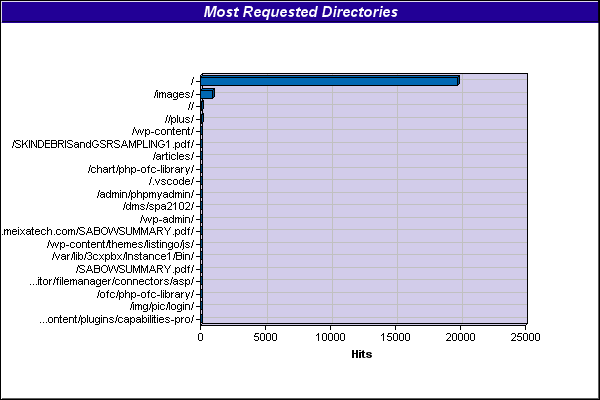
Least Popular Resource analysis shows least frequently occuring requests broken down by type, but also includes summary information across all types and directories.
Access Statistics: Least Popular Resources: Least Requested Resources |
This report displays the least requested resources on your web site. Resources include Pages, Files, Images and Misc. Web items served on your website.
Access Statistics: Least Popular Resources: Least Requested Pages |
This report shows the least requested pages on your web site. Pages are defined in the file extenstions section under Global Options.
Access Statistics: Least Popular Resources: Least Requested Files |
This report shows the least requested files on your web site. 'Files' are defined as accesses that are not Graphics, Pages or Misc. Web, such as an application with the extension .exe. Tip: Incomplete Requests are requests that were canceled in the middle of a transfer (i.e. the user got tired of waiting for the file to download and clicked the Stop button in their browser). If you have a large number of incomplete requests for a file, it's a good idea to try to reduce the size of that file or check your web server's performance.
Access Statistics: Least Popular Resources: Least Popular Images |
This report details the least requested graphics on your web site. Graphics are defined on the file extensions tab under global options. Tip: if you have a large number of incomplete requests for an image, it's a good idea to try to reduce the size of that graphic or check your web server's performance.
Access Statistics: Least Popular Resources: Least Popular Misc. Web |
This report details the least requested misc. web files on your web site. Misc. Web files types are defined in the global options under file extensions.
| File Name | Hits | Bandwidth |
|---|---|---|
| /owl-carousel/owl.carousel.js | 52 | 574.48 kilobytes |
| /css/font-awesome.min.css | 44 | 287.81 kilobytes |
| /css/style.css | 43 | 229.68 kilobytes |
| /css/menu.css | 42 | 96.40 kilobytes |
| /css/zerogrid.css | 42 | 43.52 kilobytes |
| /owl-carousel/owl.carousel.css | 40 | 23.40 kilobytes |
| /js/image-zoom.js | 5 | 4.45 kilobytes |
| /media/system/js/core.js | 5 | 1.02 kilobytes |
| /wp-includes/js/jquery/jquery.js | 4 | 856.00 bytes |
| /css/image-zoom.css | 3 | 1014.00 bytes |
| /core/misc/drupal.js | 2 | 0.00 bytes |
| /webmail/skins/elastic/styles/embed.css | 1 | 2.92 kilobytes |
| /webmail/program/js/jstz.min.js | 1 | 13.51 kilobytes |
| /webmail/plugins/jqueryui/js/i18n/jquery.ui.datepicker-fr.js | 1 | 1.10 kilobytes |
| /misc/drupal.js | 1 | 0.00 bytes |
| /webmail/program/js/list.min.js | 1 | 7.80 kilobytes |
| /webmail/program/js/jquery.min.js | 1 | 87.50 kilobytes |
| /webmail/plugins/jqueryui/js/jquery-ui.min.js | 1 | 253.69 kilobytes |
| /wp-includes/css/buttons.css | 1 | 213.00 bytes |
| /webmail/skins/elastic/styles/styles.css | 1 | 101.17 kilobytes |
| /ueditor/dialogs/internal.js | 1 | 257.00 bytes |
Access Statistics: Least Popular Resources: Least Requested Directories |
This report shows the least requested directories on your web site, which is useful for a broader look at the popularity of different areas on your web site.
Access Statistics: Hits Per day |
This report displays the number of hits per day. The report covers the entire date range of the report, except as limited by filters. You can click the Chart View button to view this graph as a chart.
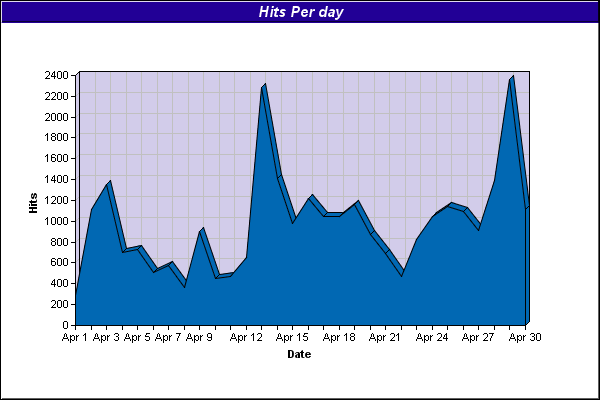
| Date/Time | Hits | Percentage |
|---|---|---|
| February 19, 2025 | 597 | 15.44% |
| February 18, 2025 | 447 | 11.56% |
| February 17, 2025 | 516 | 13.34% |
| February 16, 2025 | 681 | 17.61% |
| February 15, 2025 | 522 | 13.50% |
| February 14, 2025 | 523 | 13.52% |
| February 13, 2025 | 581 | 15.02% |
Access Statistics: Bandwidth Per day |
This report displays the number of bytes transferred per day. The report covers the entire date range of the report, except as limited by filters.
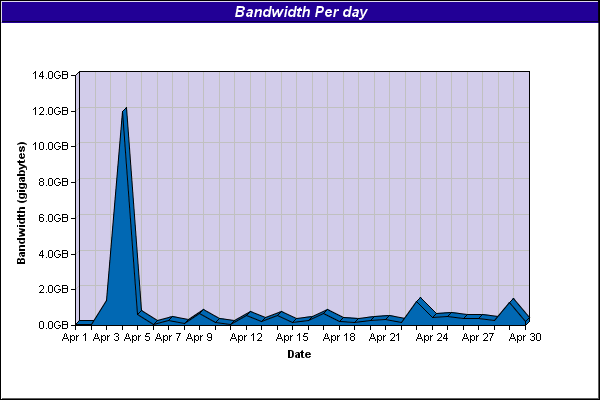
| Date/Time | Bandwidth | Percentage |
|---|---|---|
| February 19, 2025 | 857.53 megabytes | 36.92% |
| February 18, 2025 | 150.04 megabytes | 6.46% |
| February 17, 2025 | 276.55 megabytes | 11.91% |
| February 16, 2025 | 190.61 megabytes | 8.21% |
| February 15, 2025 | 318.63 megabytes | 13.72% |
| February 14, 2025 | 240.20 megabytes | 10.34% |
| February 13, 2025 | 288.90 megabytes | 12.44% |
Access Statistics: Page Views Per day |
This report shows the number of page views per day in the time period spanned by your log file. By default, Page Views refer to requests for HTML pages, while hits refer to any request for any type of file from the server. The number of page views is a better measure of web site traffic then hits because the page view number is unaffected by the number of images on each page. See also: Most Requested Files report.
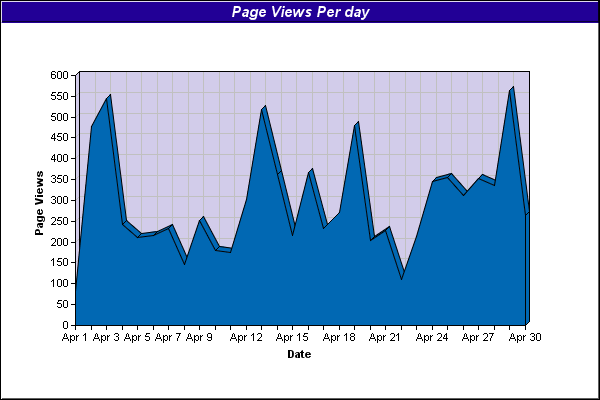
| Date/Time | Page Views | Percentage |
|---|---|---|
| February 19, 2025 | 138 | 15.03% |
| February 18, 2025 | 119 | 12.96% |
| February 17, 2025 | 130 | 14.16% |
| February 16, 2025 | 110 | 11.98% |
| February 15, 2025 | 165 | 17.97% |
| February 14, 2025 | 120 | 13.07% |
| February 13, 2025 | 136 | 14.81% |
Access Statistics: Visitors Per day |
This report displays the number of visitors per day in the time period spanned by your log file. A visitor is defined by a formula that attempts to measure the number of people who visit your web site. Hits and Page Views only measure the number of requests for pages or files; the visitor metric attempts to figure out which hits and which page views are associated with a specific user. Visitors are also called sessions or users. It must be stressed that, due to a great deal of technical considerations, this number should be taken with a grain of salt. It is certainly proportional to the number of actual people who visited your web site, but it's not a 100% accurate measure. See also: Total Visitor Stay Length and Average Visitor Stay Length.
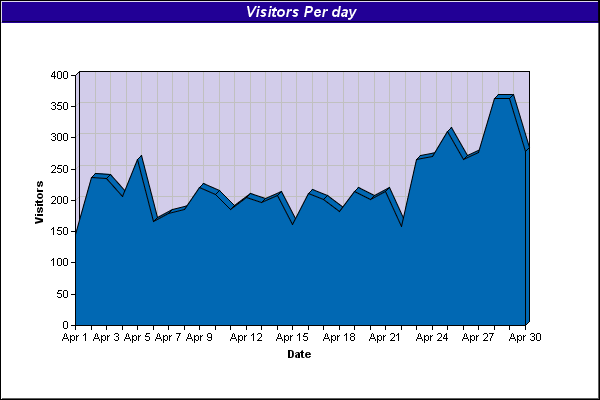
| Date/Time | Visitors per Day | Percentage |
|---|---|---|
| February 19, 2025 | 239 | 13.02% |
| February 18, 2025 | 250 | 13.62% |
| February 17, 2025 | 288 | 15.69% |
| February 16, 2025 | 221 | 12.04% |
| February 15, 2025 | 321 | 17.49% |
| February 14, 2025 | 247 | 13.46% |
| February 13, 2025 | 267 | 14.55% |
Access Statistics: Hits per Day of Week |
Tip: use this report, along with the Most Popular Hour of Day report, to schedule maintenance on your site. You can also pay attention to the number of weekend accesses -- do people browse your web site during work, or during their leisure time?
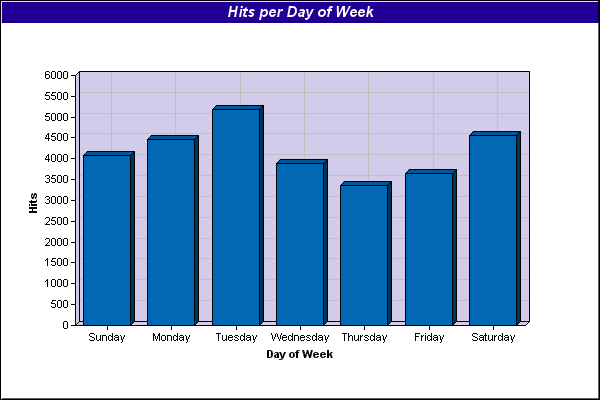
| Day of Week | Hits | Percentage |
|---|---|---|
| Sunday | 681 | 17.61% |
| Monday | 516 | 13.34% |
| Tuesday | 447 | 11.56% |
| Wednesday | 597 | 15.44% |
| Thursday | 581 | 15.02% |
| Friday | 523 | 13.52% |
| Saturday | 522 | 13.50% |
Access Statistics: Hits per Hour |
This report will tell you when traffic on our site is the heaviest. Tip: use this report to schedule web site maintenance. See also: Most Popular Day of Week.
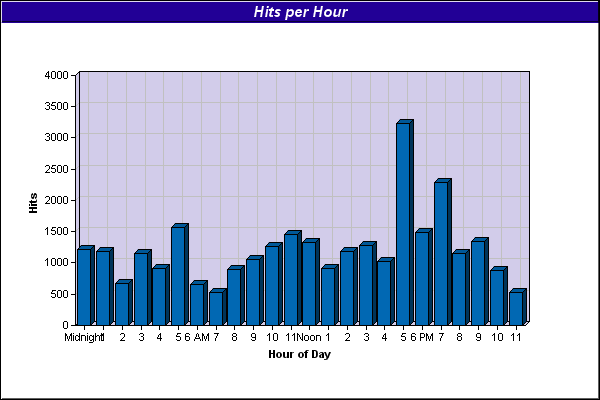
| Hour | Hits | Percentage |
|---|---|---|
| Midnight | 242 | 6.26% |
| 1 | 128 | 3.31% |
| 2 | 129 | 3.34% |
| 3 | 103 | 2.66% |
| 4 | 104 | 2.69% |
| 5 | 126 | 3.26% |
| 6 AM | 144 | 3.72% |
| 7 | 127 | 3.28% |
| 8 | 150 | 3.88% |
| 9 | 105 | 2.72% |
| 10 | 187 | 4.84% |
| 11 | 130 | 3.36% |
| Noon | 146 | 3.78% |
| 1 | 102 | 2.64% |
| 2 | 132 | 3.41% |
| 3 | 128 | 3.31% |
| 4 | 216 | 5.59% |
| 5 | 447 | 11.56% |
| 6 PM | 113 | 2.92% |
| 7 | 182 | 4.71% |
| 8 | 166 | 4.29% |
| 9 | 183 | 4.73% |
| 10 | 167 | 4.32% |
| 11 | 210 | 5.43% |
Access Statistics: Query Strings |
This report displays information about the query strings used to access your web site. Query strings are data after a ? question mark in the URL. For example, in the URL /index.html?query=variable, query is the query string and variable is the value of the query string. Query strings are typically used in dynamically generated sites. This report is most useful in conjunction with a filter that restricts on page name.
| Filename/Query String | Hits |
|---|---|
| u | 8 |
| (empty) | 8 |
| /debug/default/view?panel | 4 |
| config | 4 |
| /?rest_route | 4 |
| /wp/v2/users/ | 4 |
| /wp-content/plugins/apikey/apikey.php?test | 3 |
| hello | 3 |
| rsd | 3 |
| (empty) | 3 |
| /img/xmrlpc.php?p | 2 |
| (empty) | 2 |
| /wp-admin/css/colors/blue/xmrlpc.php?p | 2 |
| (empty) | 2 |
| /css/xmrlpc.php?p | 2 |
| (empty) | 2 |
| /.well-known/pki-validation/xmrlpc.php?p | 2 |
| (empty) | 2 |
| /wp-admin/admin-ajax.php?action | 2 |
| duplicator_download | 1 |
| revslider_show_image | 1 |
| /wp-admin/network/xmrlpc.php?p | 2 |
| (empty) | 2 |
| /wp-admin/images/xmrlpc.php?p | 2 |
| (empty) | 2 |
| /wp-admin/xmrlpc.php?p | 2 |
| (empty) | 2 |
| /wp-admin/css/colors/coffee/xmrlpc.php?p | 2 |
| (empty) | 2 |
| /images/xmrlpc.php?p | 2 |
| (empty) | 2 |
| /wp-admin/css/colors/xmrlpc.php?p | 2 |
| (empty) | 2 |
| /wp-admin/includes/xmrlpc.php?p | 2 |
| (empty) | 2 |
| /cgi-bin/xmrlpc.php?p | 2 |
| (empty) | 2 |
| /xmrlpc.php?p | 2 |
| (empty) | 2 |
| /wp-admin/user/xmrlpc.php?p | 2 |
| (empty) | 2 |
| /feed/?paged | 2 |
| 1 | 1 |
| 2 | 1 |
| /.well-known/acme-challenge/xmrlpc.php?p | 2 |
| (empty) | 2 |
| /wp-admin/js/widgets/xmrlpc.php?p | 2 |
| (empty) | 2 |
| /app_dev.php/_profiler/open?file | 2 |
| app/config/parameters.yml | 2 |
| /wp-content/plugins/wp-file-upload/wfu_file_downloader.php?0 | 1 |
| echo 'cmFnYTNkYXdsZWRpYWppaG5heWE=' | base64 --decode | 1 |
| /admin/web/index.php?lang | 1 |
| en | 1 |
| /api/index.php/v1/config/application?public | 1 |
| true | 1 |
| /wp-content/plugins/wp-file-upload/wfu_file_downloader.php?d... | 1 |
| 0 | 1 |
| /wordpress/wp-admin/setup-config.php?step | 1 |
| 1 | 1 |
| /admin/phpmyadmin/index.php?lang | 1 |
| en | 1 |
| /wp-admin/admin-ajax.php?file | 1 |
| ../wp-config.php | 1 |
| /wp-content/plugins/wp-file-upload/wfu_file_downloader.php?t... | 1 |
| H | 1 |
| /?source | 1 |
| 1 | |
| /wp-content/plugins/wp-file-upload/wfu_file_downloader.php?w... | 1 |
| wp_wpfileupload_9 | 1 |
| /wp-content/plugins/wp-file-upload/wfu_file_downloader.php?d... | 1 |
| cookies | 1 |
| /wp-content/plugins/wp-file-upload/wfu_file_downloader.php?s... | 1 |
| 1 | 1 |
| /wp-content/plugins/wp-file-upload/wfu_file_downloader.php?f... | 1 |
| p | 1 |
| /wp-admin/setup-config.php?step | 1 |
| 1 | 1 |
| /__phpmyadmin/index.php?lang | 1 |
| en | 1 |
| /?gf_page | 1 |
| upload | 1 |
| /wp-content/plugins/wp-file-upload/wfu_file_downloader.php?h... | 1 |
| dboption | 1 |
| /wp-admin/admin-ajax.php?img | 1 |
| ../wp-config.php | 1 |
* Do you want to see whether or not your site is the kind of site that visitors will return to? * Do you want to know if your site is driving sales after a marketing campaign? * Are your visitors able to find the information they are looking for quickly and efficiently? * Do your readers actually spend time reading the material on your site that you think is interesting? * Where do different kinds of users come from when they come to your site? Gathering and analyzing information is never easy. There's no "poof" report to do your thinking for you. Instead, FastStats Analyzer gives you powerful tools that can provide you with information to answer these and other difficult questions.
Site "Stickiness": Site Entry Pages |
The Site Entry Pages Report details where visitors most frequently enter your web site. These pages are the most frequently linked to pages on your web site. Your site entry pages are visitors' first impression of your web site. Site entry pages should be a) relatively small and quick to load, b) flashy, so they grab a user's attention, and c) informative -- make sure visitors can find what they're looking for quickly and easily from the site entry page.
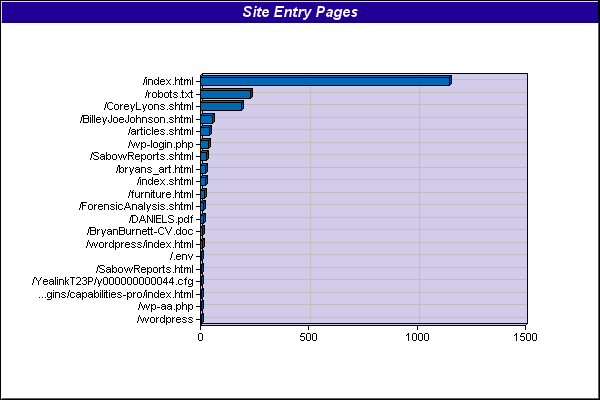
Site "Stickiness": Site Exit Pages |
A site exit page is the last web page on your site a user visited. While some web sites do have logical end points, it is often the case that site exit pages are weak pages that could use improvement to increase visitor retention. It is advisable that you spend time and try to make common site exit pages more interesting. Remember that a site exit page is the last web page on your web site that users visit. A page that links to a 3rd party web site will appear to be a site exit page, even though you may have intended for users to go to that 3rd party web site.
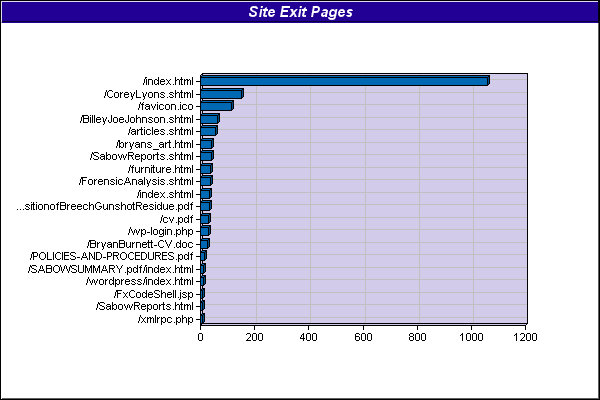
Site "Stickiness": Single Access Pages |
Promotional pages should spark interest. Unless the page is more or less self contained, you may want your vistors to browse other parts of your site. For visitors that did go to other places, where did they go? You can use the HyperLink Treeview to determine where. You can see which pages need more work to direct traffic where you would like it to go, and with the single access page report, you can then tune these pages to increase their effectiveness as you see fit.
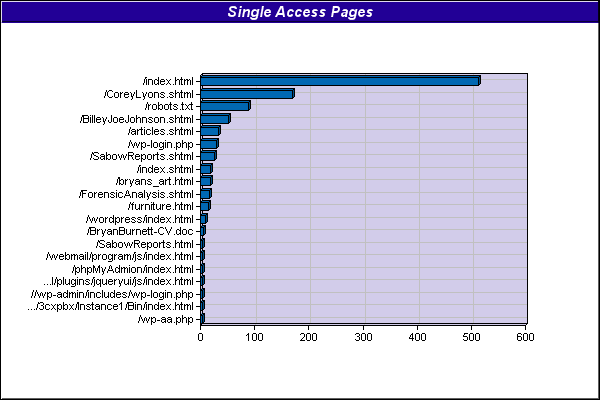
Average Stay Length measures site interest, utility and captivity, but can also point to site navigation inefficency. If users appear to be browsing through a broad variety of links and commonly landing on just a few of them you may want to make sure the final pages are easy to find.
Site "Stickiness": Average Stay Lengths: Avg. Stay Length per Referrer |
This report shows you which web pages sent you interested visitors. An interested visitor will spend a lot of time on your web site, while an uninterested visitor will spend a short amount of time. A referring web page is a web page that a user visited just before their clicked on your web site; these web pages can be advertising partners or simply web pages with links to your site. Web pages that send interested visitors your way are more valuable partners than web pages that send uninterested visitors; there is little value in users spending a short amount of time on your web site. This report is similar to the Avg. Stay Length per Referring Domain report, only it breaks down the statistics by individual pages instead of by entire referral site. Like the Avg. Stay Length per Referring Domain report, this report is useful for determining the efficacy of advertisements and partnerships.
Site "Stickiness": Average Stay Lengths: Avg. Stay Length per Referring Domain |
This report shows you which domains sent you interested visitors. An interested visitor will spend a lot of time on your web site, while an uninterested visitor will spend a short amount of time. A referring domain is a web site that the user visited just before their clicked on your web site; these sites can be advertising partners or simply web pages with links to your site. Domains that send interested visitors your way are more valuable partners than domains that send uninterested visitors; there is little value in users spending a short amount of time on your web site. To see the reports broken down by the specific web page on the referring domain, see the Avg. Stay Length per Referrer report.
| Referring Domain | Average Tme per Session | Average Hits per Session | Sessions | Pct. of Total Page Views | Pct. of Total Sessions |
|---|---|---|---|---|---|
| No Referrer | 04 minutes, 18 seconds | 4 | 1533 | 73.20% | 83.54% |
| google.com | 01 second | 11 | 17 | 1.20% | 0.93% |
| forensicsciencetodaykin.blogspot.com | 00 seconds | 0 | 1 | 0.00% | 0.05% |
| pv-services.ru | 00 seconds | 0 | 1 | 0.11% | 0.05% |
| candlepowerforums.com | 00 seconds | 0 | 1 | 0.00% | 0.05% |
| newpol54.ru | 00 seconds | 0 | 3 | 0.00% | 0.16% |
| proftests.com | 00 seconds | 0 | 3 | 0.00% | 0.16% |
| m.baidu.com | 00 seconds | 0 | 3 | 0.22% | 0.16% |
| dg-s.ru | 00 seconds | 0 | 3 | 0.00% | 0.16% |
| shoahph.com | 00 seconds | 0 | 1 | 0.00% | 0.05% |
| nsk-bagazh-anturazh.ru | 00 seconds | 0 | 1 | 0.00% | 0.05% |
| xn----8sb2atp.xn--p1ai | 00 seconds | 0 | 3 | 0.00% | 0.16% |
| castboolits.gunloads.com | 00 seconds | 0 | 1 | 0.00% | 0.05% |
| en.wikipedia.org | 00 seconds | 0 | 1 | 0.11% | 0.05% |
| proftests.net | 00 seconds | 0 | 3 | 0.00% | 0.16% |
| cameralensmanufacturers.com | 00 seconds | 0 | 1 | 0.00% | 0.05% |
| salem-news.com | 00 seconds | 0 | 1 | 0.00% | 0.05% |
| druzhbany.ru | 00 seconds | 0 | 3 | 0.00% | 0.16% |
Site "Stickiness": Average Stay Lengths: Avg. Stay Length per Search Engine |
The number of interested visitors a search engine sends to your web site is more important than the sheer number of visitors a search engine sends to you -- especially if those users were delivered via a pay-per-click program (and not just a straight web search). Interested visitors -- visitors who spend a lot of time on your web site -- are more valuable than uninterested visitors. The most valuable search engine campaigns are the ones that send you large numbers of users who spend lots of time at your web site. Used in conjunction with the Avg. Stay Length per Search Phrase report, you can see which keywords are the most effective in bringing useful visitors to your site. Keywords that bring visitors that stay the longest are likely worth more money than keywords that don't bring interested users.
There were no items in this report.
Site "Stickiness": Average Stay Lengths: Avg. Stay Length per Search Phrase |
Good keywords bring interested visitors that spend time on your site. One way to figure out how much to spend on search keywords at a search engine site is to compute the number of sales per visitor, determine the profit per sale, and then figure out the profit per visitor. Pay-per-click keyword purchase arramgements can help you control costs and pay only for the visitors that come to your site. However, some keywords are worth more (and cost more) than others. You may find that you wish to pay more for the keywords that bring the most interested visitors to your site. Use this report in conjunction with the Average Stay per Search Engine report to determine where your efforts are most greatly rewarded.
There were no items in this report.
Site "Stickiness": Average Stay Lengths: Avg. Stay Length per Site Entry |
A site entry page is the first page that a user sees when she visits your web site. This page is crucial; it must grab her attention and make her want to visit other pages on the web site. You can determine the efficacy of individual site entry pages by examining this report and seeing how long users stayed on your web site depending on the entry page. Measuring Marketing Campaign Effectiveness By providing a different entry page for each marketing campaign, you can see which campaigns bring the most interested visitors. Is a content change to an entry page helping or hurting? Using a date filter, look at the average visitor stay length before the change and after. Did it increase or decrease?
| Originating Entry Page | Average Tme per Session | Average Hits per Session | Sessions | Pct. of Total Page Views | Pct. of Total Sessions |
|---|---|---|---|---|---|
| /robots.txt | 34 minutes, 23 seconds | 4 | 44 | 8.17% | 2.40% |
| /index.html | 39 seconds | 4 | 408 | 64.16% | 22.23% |
| /index.shtml | 49 minutes, 44 seconds | 9 | 7 | 0.98% | 0.38% |
| /wp-content/plugins/WordPressCore/include.php | 04 minutes, 57 seconds | 4 | 1 | 0.44% | 0.05% |
| /images/favicon.ico | 03 minutes, 21 seconds | 4 | 1 | 0.44% | 0.05% |
| /SABOW | 03 seconds | 2 | 1 | 0.22% | 0.05% |
| /Public/admin/webuploader/server/preview.php | 02 seconds | 2 | 1 | 0.22% | 0.05% |
| /SABOW/index.html | 01 second | 2 | 1 | 0.22% | 0.05% |
| /.env | 01 second | 2 | 1 | 0.22% | 0.05% |
| /phpcms/libs/classes/index.html | 00 seconds | 0 | 1 | 0.11% | 0.05% |
| /articles/NoseorBaseStrike.html | 00 seconds | 0 | 2 | 0.22% | 0.11% |
| /CoreyLyons.shtml | 00 seconds | 0 | 2 | 0.22% | 0.11% |
| /articles/MacroImagingwithaDigitalCamera.html | 00 seconds | 0 | 3 | 0.33% | 0.16% |
| /users/sign_in/index.html | 00 seconds | 0 | 1 | 0.11% | 0.05% |
| /furniture.html | 00 seconds | 0 | 1 | 0.11% | 0.05% |
| /syslogin/php/fileupload1.php | 00 seconds | 0 | 1 | 0.11% | 0.05% |
| /BilleyJoeJohnson.shtml | 00 seconds | 0 | 2 | 0.22% | 0.11% |
| /DoJtoHunter2007B.pdf | 00 seconds | 0 | 1 | 0.11% | 0.05% |
| /articles/index.html | 00 seconds | 0 | 1 | 0.11% | 0.05% |
| /signupmember/index.html | 00 seconds | 0 | 1 | 0.11% | 0.05% |
| /Art2.shtml | 00 seconds | 0 | 4 | 0.44% | 0.22% |
| /astra/index.html | 00 seconds | 0 | 1 | 0.11% | 0.05% |
| /coremail/common/help/images/index.html | 00 seconds | 0 | 1 | 0.11% | 0.05% |
| /cgi-f/webmail/static/index.html | 00 seconds | 0 | 1 | 0.11% | 0.05% |
| /beta/wp-content/themes/AdvanceImage5/index.html | 00 seconds | 0 | 1 | 0.11% | 0.05% |
| /images/art/index.html | 00 seconds | 0 | 1 | 0.11% | 0.05% |
| /ForensicAnalysis.shtml | 00 seconds | 0 | 4 | 0.44% | 0.22% |
| /articles.shtml | 00 seconds | 0 | 4 | 0.44% | 0.22% |
| /Art3.shtml | 00 seconds | 0 | 6 | 0.65% | 0.33% |
| /SabowReports.html | 00 seconds | 0 | 2 | 0.22% | 0.11% |
| /Haney- | 00 seconds | 0 | 1 | 0.11% | 0.05% |
| /SabowReports.shtml | 00 seconds | 0 | 11 | 1.20% | 0.60% |
Site "Stickiness": Visitor Page Views |
Is your site being browsed for long periods of time, or are most of your visitors only looking at a couple of pages? For parts of your site that focus on advertising, promotion, and information content, you want your visitors to look around. If they look through lots of pages, that's a sign that they're interested in your site content. And if you are selling something, it's a sign that they are thinking about making a purchase. Conversely, having too many page views can also be a sign of site inefficiency. If visitors are looking for something specific (i.e. they are at the technical support section of your web site) and have to click through lots of pages to find what they are looking for, they may get annoyed, but persist because of need. You want your site to be efficient for people who are looking for specific things. See also the Session Length Histogram.
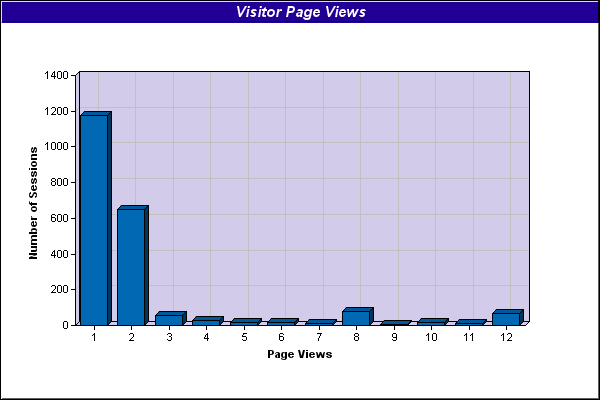
| Page Views | Sessions | Average Session Length |
|---|---|---|
| 1 | 356 | 00 seconds |
| 2 | 118 | 03 minutes, 38 seconds |
| 3 | 29 | 07 minutes, 57 seconds |
| 4 | 12 | 03 minutes, 14 seconds |
| 5 | 3 | 04 seconds |
Site "Stickiness": Visitor Session Length |
The Session Length Historgram can give you a feel for the distribution of visitors by the time they spend on your site. It's likely that users will either come for a quick glance or will stay awhile, but which they do matters, depending on where they are in your site. In the support areas of your site, you want users to find what they need fast (use Analyzer's filtering capabilties to analyze only your support sections). In the purchase, promotion, and informational areas of your site, you want them to spend some time and show some interest (use Analyzer's filtering capabilties to analyze only your support sections). Use the site filtering mechanism to drill down on your site to look at specific parts of it, and use the Session Length Histogram to determine if that part of your site needs work.
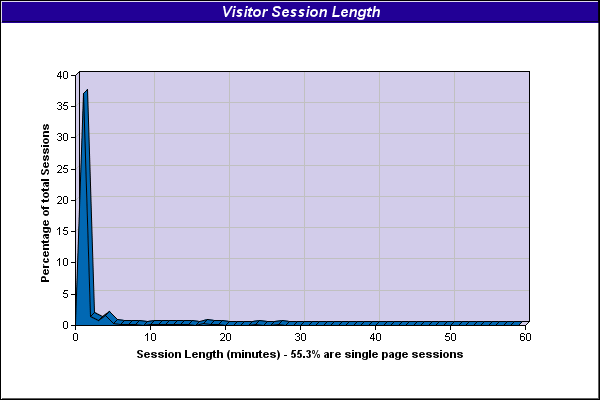
| Session Length | Percent of Total Sessions | Sessions |
|---|---|---|
| >60 | 0.97% | 5 |
| 59 | 0.00% | 0 |
| 58 | 0.00% | 0 |
| 57 | 0.00% | 0 |
| 56 | 0.00% | 0 |
| 55 | 0.00% | 0 |
| 54 | 0.00% | 0 |
| 53 | 0.00% | 0 |
| 52 | 0.00% | 0 |
| 51 | 0.00% | 0 |
| 50 | 0.00% | 0 |
| 49 | 0.19% | 1 |
| 48 | 0.00% | 0 |
| 47 | 0.00% | 0 |
| 46 | 0.00% | 0 |
| 45 | 0.00% | 0 |
| 44 | 0.00% | 0 |
| 43 | 0.00% | 0 |
| 42 | 0.00% | 0 |
| 41 | 0.00% | 0 |
| 40 | 0.00% | 0 |
| 39 | 0.00% | 0 |
| 38 | 0.00% | 0 |
| 37 | 0.00% | 0 |
| 36 | 0.00% | 0 |
| 35 | 0.00% | 0 |
| 34 | 0.00% | 0 |
| 33 | 0.00% | 0 |
| 32 | 0.00% | 0 |
| 31 | 0.00% | 0 |
| 30 | 0.00% | 0 |
| 29 | 0.00% | 0 |
| 28 | 0.19% | 1 |
| 27 | 0.19% | 1 |
| 26 | 0.19% | 1 |
| 25 | 0.00% | 0 |
| 24 | 0.00% | 0 |
| 23 | 0.00% | 0 |
| 22 | 0.00% | 0 |
| 21 | 0.00% | 0 |
| 20 | 0.00% | 0 |
| 19 | 0.00% | 0 |
| 18 | 0.00% | 0 |
| 17 | 0.00% | 0 |
| 16 | 0.00% | 0 |
| 15 | 0.00% | 0 |
| 14 | 0.19% | 1 |
| 13 | 0.00% | 0 |
| 12 | 0.00% | 0 |
| 11 | 0.00% | 0 |
| 10 | 0.00% | 0 |
| 9 | 0.00% | 0 |
| 8 | 0.39% | 2 |
| 7 | 0.19% | 1 |
| 6 | 0.00% | 0 |
| 5 | 0.00% | 0 |
| 4 | 0.19% | 1 |
| 3 | 0.39% | 2 |
| 2 | 0.19% | 1 |
| 1 | 27.99% | 145 |
Site "Stickiness": Page Views per Session Summary |
This report shows you the number of page views per session. The more page views in a single session, the more interested that particular user was in your web site. If viewers are confused and not able to find what they're looking for, then they'll only view a few pages before they become frustrated and leave. Use this report in conjunction with the Site Exit Pages report; when the average number of pages views on your site drops, examine the Site Exit Pages report and see which pages are causing your site to lose visitors. Signs of an interesting site: An interesting site will have lots of page views and users will be spending lots time on these pages. Use this report and the Average Visitor Stay Length report to measure this information. Signs of a confusing site: If users are browsing quickly through lots of pages on your site, they are likely looking for something specific, but are lost.
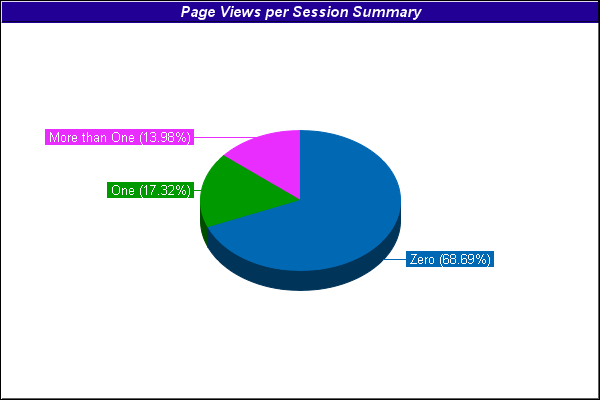
| Number of Page Views | Number of Sessions | Percentage |
|---|---|---|
| Zero | 1315 | 71.74% |
| One | 356 | 19.42% |
| More than One | 162 | 8.84% |
Site "Stickiness": Session Length Summary |
One way to measure users interest in your site is to see how long, on average, each visitor stays on your web site. Average visitor stay length is measured from the start of their first page view to the end of their last page view. Used in conjunction with Average Page Views per Session, you can get a sense for how interesting your web site is. Used alone, you can see immediately if users came for just a quick glance or if they spent some time on your site. Use Analyzer's filtering capabilities (New Report: Edit Report: Filters: Add) to restrict the analysis to a directory or a set of several pages. Look at the change in how much time users spend on those pages and try to correlate the change in average session length with any changes you may have made to your web site. The Total Visitor Stay Length report gives you similar information, but also includes your site's popularity, since that report also depends upon the number of visitors to your site.
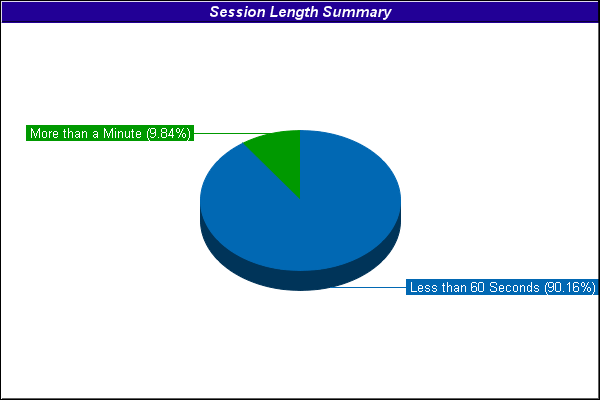
| Session Length | Number of Sessions | Percentage |
|---|---|---|
| Less than 60 Seconds | 498 | 96.14% |
| More than a Minute | 20 | 3.86% |
Site "Stickiness": Average Visitor Stay Length |
Site "Stickiness": Average Page Views per Session |
Site "Stickiness": New vs. Returning Visitors |
Site "Stickiness": Average Length Between Visits |
Site "Stickiness": Sessions per User |
Referrer Statistics show you who is bringing you traffic. * Are you doing a marketing campaign? * Inerested in enhancing your search engine performance? * Which search engines bring you the most traffic? Are some being left out? * Do you need to see if a partnership is performing to your expectations?
Referrer Information: Referrer Origin |
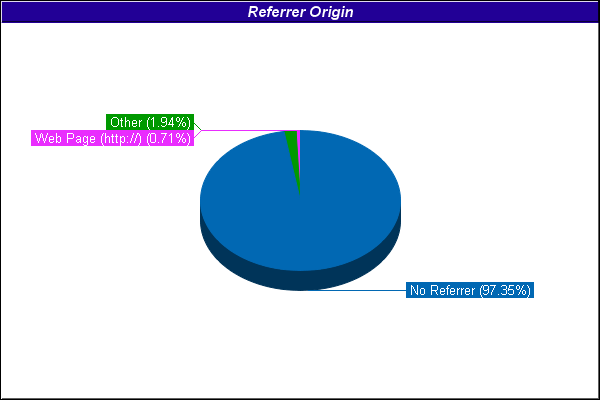
| Referrer Origin | Hits | Percentage |
|---|---|---|
| E-mail Message (mailto://) | 0 | 0.00% |
| Newsgroup (news://) | 0 | 0.00% |
| Web Page (http://) | 38 | 1.28% |
| FTP Site (ftp://) | 0 | 0.00% |
| Other | 44 | 1.48% |
| No Referrer | 2891 | 97.24% |
| Local Files (file://) | 0 | 0.00% |
Referrer Information: Referring Domain |
The Referring Domains Report tells you how visitors got to your web site. Referring domains contain sites that link to your web site, including search engines. This report provides a useful, strategic overview of external links to your web site and search engine placement.
Referrer Information: Referring Pages |
Referring pages are web pages with links to your web site. The Referring Pages Report tells you which pages are sending the most traffic to your site. You should identify those pages generating the most traffic to your site and ensure those links remain prominent. See also: Referring Domains and Individual Page Referrers.
Referrer Information: Individual Page Referrers |
The Individual Page Referrers Report is similar to the Referring Pages Report; it breaks down the referring pages by the page that directed users to your site. The names of the pages requested are first, with the linking web sites listed below. This is extremely useful if your web site markets more than one product, or has more than one area of interest. Each product/area of interest may be linked to by a completely different set of referrers. See also: Referring Domains and Referring Pages.
Referrer Information: Search Engines |
This report displays the total number of hits received from each of the most popular search engines. You can use this report to figure out which search engines you should concentrate your efforts on (i.e., which search engines are driving the least traffic your way). See also: Search Engine Phrases and Search Engine Keywords.
There were no items in this report.
Referrer Information: Search Engine Keywords |
This report displays the keywords visitors most frequently used to search for your site. Keywords are single words within search phrases. This report is different from the Referrer Information | Search Engine Phrases report in that it breaks down the individual words in the search query; for example, the "Phrases" report would record a search for "FastStats Analyzer Software", while the Keywords report would record "FastStats Analyzer" and Software.
There were no items in this report.
Referrer Information: Search Engine Phrases |
This report displays the phrases visitors most frequently use to search for your web site. This report is perhaps the most important report in Mach5 Analyzer -- studies show that the majority of users enter web sites through a search engine. High ranking for important keywords and phrases in search engines is key to driving visitors to your web site. See also: Search Engine Keywords and Search Engine Performance.
There were no items in this report.
Technical Statistics Whether it's missing pages, bad links to your site, problems with server performance...... ....get the inside view of problems before they hit your bottom line. Regular use of FastStats Analyzer to check your site for errors and broken transfers can alert you to problems with your site before your visitors do.
Technical Information: 404 Errors |
404 errors occur when the file requested by a user was not found. This report displays a record of any 404 errors encountered by visitors in the log file's time span. 404 errors are generally caused by bad links on either your web site or a web site that links to your site. You should eliminate as many 404 errors as possible. See also: 404 Error Referrers
| Requested URL | Occurrences |
|---|---|
| /js/script.js | 104 |
| /js/jquery1111.min.js | 101 |
| /media/system/js/core.js | 15 |
| /wp-includes/js/jquery/jquery.js | 14 |
| /.env | 11 |
| /PART%202%20LYONS%20HOMICIDE.pdf | 10 |
| /blake.pdf | 8 |
| /PART%203%20LYONS%20HOMICIDE.pdf | 8 |
| /SCHARTON%20HOMICIDE.pdf | 8 |
| /LEWIS-AUTOPSY%201.pdf | 7 |
| /David%20Nicholas.pdf | 7 |
| /contact.html | 7 |
| /SABOWREPORT-%20BURNETT.pdf | 7 |
| /.well-known/traffic-advice | 6 |
| /LEWIS-AUTOPSY%202.pdf | 6 |
| /PART%201%20LYONS%20HOMICIDE.pdf | 6 |
| /LYONS%20GSR%20SCIENCE%20TO%20JUNK.pdf | 6 |
| /sitemap.xml | 6 |
| /home | 5 |
| /wordpress | 5 |
| /.git/config | 5 |
| /html5.js | 5 |
| /bc | 4 |
| /css3-mediaqueries.js | 4 |
| /BLAKE.pdf | 4 |
| /.well-known/acme-challenge/cloud.php | 4 |
| /wp | 4 |
| /old | 4 |
| /.vscode/sftp.json | 4 |
| /main | 4 |
| /new | 4 |
| /wp-admin/js/about.php | 4 |
| /image-zoom.js | 4 |
| /bk | 4 |
| /backup | 4 |
| /HomicideInMississippi.pdf | 4 |
| /config.json | 4 |
| /wp/wp-includes/wlwmanifest.xml | 3 |
| /test/wp-includes/wlwmanifest.xml | 3 |
| /weathermap/ | 3 |
| /config/index.html | 3 |
| /FxCodeShell.jsp | 3 |
| /Scott.pdf | 3 |
| /sitemap.txt | 3 |
| /web/wp-includes/wlwmanifest.xml | 3 |
| /site/wp-includes/wlwmanifest.xml | 3 |
| /shop/wp-includes/wlwmanifest.xml | 3 |
| /wordpress/wp-includes/wlwmanifest.xml | 3 |
| /FLECHTNER.pdf | 3 |
| /SABOWSUMMARY.pdf/ | 3 |
| /wp1/wp-includes/wlwmanifest.xml | 3 |
| /2019/wp-includes/wlwmanifest.xml | 3 |
| /autodiscover/autodiscover.xml | 3 |
| /vpn/index.html | 3 |
| /sitemap.xml.gz | 3 |
| /sitemap_index.xml | 3 |
| /BURNETT | 3 |
| /cms/wp-includes/wlwmanifest.xml | 3 |
| /FRAUDULENTIMAGE.pdf.%C2%A0%C2%A0 | 3 |
| /server-status | 3 |
| /blog/wp-includes/wlwmanifest.xml | 3 |
| /wp-includes/images/about.php | 2 |
| /wp-admin/css/colors/coffee/xmrlpc.php?p= | 2 |
| /wp-content/banners/about.php | 2 |
| /wp-content/plugins/wp-theme-editor/include.php | 2 |
| /PROBABLE_CAUSE.pdf | 2 |
| /info | 2 |
| /wp-content/plugins/seoo/wsoyanz1.php | 2 |
| /s/230323e27393e25353e2631323/_/;/META-INF/maven/com.atlassi... | 2 |
| /wp-admin/css/index.php | 2 |
| /BryanBurnett-CV.doc%C2%B7 | 2 |
| /wp-content/plugins/wp-conflg.php | 2 |
| /wp-includes/repeater.php | 2 |
| /wp-admin/dropdown.php | 2 |
| /wp-includes/blocks/about.php | 2 |
| /alfanew.php7 | 2 |
| /wp-content/repeater.php | 2 |
| /wp-content/plugins/seoo/wsoyanz.php | 2 |
| /wp-includes/block-patterns/about.php | 2 |
| /wp-includes/style-engine/about.php | 2 |
| /alfanew2.php7 | 2 |
| /wp-content/plugins/simple/simple.php | 2 |
| /wp-admin/user/xmrlpc.php?p= | 2 |
| /img/about.php | 2 |
| /wp-content/plugins/Cache/Cache.php | 2 |
| /wp-content/themes/seotheme/db.php?u | 2 |
| /wp-content/plugins/linkpreview/db.php?u | 2 |
| /cgi-bin/about.php | 2 |
| /img/xmrlpc.php?p= | 2 |
| /wp-admin/js/widgets/about.php7 | 2 |
| /libraries/phpmailer/updates.php | 2 |
| /wp-content/plugins/awesome-coming-soon/come.php | 2 |
| /wp-content/plugins/WordPressCore/include.php | 2 |
| /wp-includes/ID3/about.php | 2 |
| /wp-includes/SimplePie/about.php | 2 |
| /adminfuns.php7 | 2 |
| /wp-content/plugins/seoplugins/db.php?u | 2 |
| /wp-admin/network/cloud.php | 2 |
| /ebs.php7 | 2 |
| /wp-content/updates.php | 2 |
Technical Information: 404 Page Referrers |
This reports shows both 404 server errors (missing pages), and the web sites that linked to these missing files. The names of the pages requested are first, with the linking web sites listed below. This report is extremely useful in eliminating 404 errors. The filename in the chart represents the missing file, and the referrers are the pages that link to the missing file. If the referrer of a 404 error is from your web site, you should immediately find the page and correct the bad link. If the referrer is on an external web site, notify that site's web administrator immediately. 404 errors prevent users from getting the information they need from your web site.
| Filename/Referring URL | Hits |
|---|---|
| /js/script.js | 104 |
| https://meixatech.com/ | 79 |
| No Referrer | 11 |
| http://meixatech.com/ | 7 |
| https://meixatech.com/Art2.shtml | 3 |
| https://meixatech.com/Art3.shtml | 1 |
| https://meixatech.com/index.shtml | 1 |
| http://meixatech.com/Art2.shtml | 1 |
| http://meixatech.com/Art3.shtml | 1 |
| /js/jquery1111.min.js | 101 |
| https://meixatech.com/ | 78 |
| No Referrer | 10 |
| http://meixatech.com/ | 7 |
| https://meixatech.com/Art2.shtml | 2 |
| https://meixatech.com/Art3.shtml | 1 |
| https://meixatech.com/index.shtml | 1 |
| http://meixatech.com/Art2.shtml | 1 |
| http://meixatech.com/Art3.shtml | 1 |
| /media/system/js/core.js | 15 |
| No Referrer | 10 |
| http://www.meixatech.com/media/system/js/core.js | 5 |
| /wp-includes/js/jquery/jquery.js | 14 |
| No Referrer | 10 |
| http://www.meixatech.com/wp-includes/js/jquery/jquery.js | 4 |
| /.env | 11 |
| No Referrer | 11 |
| /PART%202%20LYONS%20HOMICIDE.pdf | 10 |
| http://www.meixatech.com/PART 2 LYONS HOMICIDE.pdf | 8 |
| No Referrer | 2 |
| /PART%203%20LYONS%20HOMICIDE.pdf | 8 |
| http://www.meixatech.com/PART 3 LYONS HOMICIDE.pdf | 7 |
| No Referrer | 1 |
| /SCHARTON%20HOMICIDE.pdf | 8 |
| http://www.meixatech.com/SCHARTON HOMICIDE.pdf | 8 |
| /blake.pdf | 8 |
| No Referrer | 8 |
| /contact.html | 7 |
| http://meixatech.com | 3 |
| http://meixatech.com/contact.html | 2 |
| No Referrer | 2 |
| /SABOWREPORT-%20BURNETT.pdf | 7 |
| http://www.meixatech.com/SABOWREPORT- BURNETT.pdf | 6 |
| No Referrer | 1 |
| /David%20Nicholas.pdf | 7 |
| http://www.meixatech.com/David Nicholas.pdf | 7 |
| /LEWIS-AUTOPSY%201.pdf | 7 |
| http://www.meixatech.com/LEWIS-AUTOPSY 1.pdf | 7 |
| /LEWIS-AUTOPSY%202.pdf | 6 |
| http://www.meixatech.com/LEWIS-AUTOPSY 2.pdf | 6 |
| /LYONS%20GSR%20SCIENCE%20TO%20JUNK.pdf | 6 |
| http://www.meixatech.com/LYONS GSR SCIENCE TO JUNK.pdf | 6 |
| /PART%201%20LYONS%20HOMICIDE.pdf | 6 |
| http://www.meixatech.com/PART 1 LYONS HOMICIDE.pdf | 6 |
| /.well-known/traffic-advice | 6 |
| No Referrer | 6 |
| /sitemap.xml | 6 |
| https://www.meixatech.com/sitemap.xml | 3 |
| No Referrer | 3 |
| /.git/config | 5 |
| No Referrer | 5 |
| /html5.js | 5 |
| No Referrer | 5 |
| /home | 5 |
| No Referrer | 5 |
| /wordpress | 5 |
| No Referrer | 5 |
| /.well-known/acme-challenge/cloud.php | 4 |
| No Referrer | 4 |
| /wp | 4 |
| No Referrer | 4 |
| /css3-mediaqueries.js | 4 |
| No Referrer | 4 |
| /config.json | 4 |
| No Referrer | 4 |
| /old | 4 |
| No Referrer | 4 |
| /backup | 4 |
| No Referrer | 4 |
| /bk | 4 |
| No Referrer | 4 |
| /.vscode/sftp.json | 4 |
| No Referrer | 4 |
| /main | 4 |
| No Referrer | 4 |
| /new | 4 |
| No Referrer | 4 |
| /bc | 4 |
| No Referrer | 4 |
| /wp-admin/js/about.php | 4 |
| No Referrer | 4 |
| /BLAKE.pdf | 4 |
| No Referrer | 4 |
| /HomicideInMississippi.pdf | 4 |
| No Referrer | 4 |
| /image-zoom.js | 4 |
| No Referrer | 4 |
| /sitemap.txt | 3 |
| No Referrer | 3 |
| /FLECHTNER.pdf | 3 |
| No Referrer | 2 |
| https://meixatech.com/articles.shtml | 1 |
| /BURNETT | 3 |
| No Referrer | 3 |
| /feed/index.html | 3 |
| https://meixatech.com/feed/ | 2 |
| No Referrer | 1 |
| /cms/wp-includes/wlwmanifest.xml | 3 |
| No Referrer | 3 |
| /BryanBurnett-CV.doc/index.html | 3 |
| No Referrer | 3 |
| /web/wp-includes/wlwmanifest.xml | 3 |
| No Referrer | 3 |
| /wordpress/wp-includes/wlwmanifest.xml | 3 |
| No Referrer | 3 |
| /config/index.html | 3 |
| No Referrer | 3 |
| /sitemap.xml.gz | 3 |
| No Referrer | 3 |
| /FRAUDULENTIMAGE.pdf.%C2%A0%C2%A0 | 3 |
| No Referrer | 3 |
| /shop/wp-includes/wlwmanifest.xml | 3 |
| No Referrer | 3 |
| /vpn/index.html | 3 |
| No Referrer | 3 |
| /SABOWSUMMARY.pdf/index.html | 3 |
| No Referrer | 3 |
| /wp1/wp-includes/wlwmanifest.xml | 3 |
| No Referrer | 3 |
| /blog/wp-includes/wlwmanifest.xml | 3 |
| No Referrer | 3 |
| /Scott.pdf | 3 |
| No Referrer | 3 |
| /site/wp-includes/wlwmanifest.xml | 3 |
| No Referrer | 3 |
| /FxCodeShell.jsp | 3 |
| No Referrer | 3 |
| /autodiscover/autodiscover.xml | 3 |
| No Referrer | 3 |
| /wp/wp-includes/wlwmanifest.xml | 3 |
| No Referrer | 3 |
| /test/wp-includes/wlwmanifest.xml | 3 |
| No Referrer | 3 |
| /weathermap/index.html | 3 |
| No Referrer | 3 |
| /sitemap_index.xml | 3 |
| No Referrer | 3 |
| /2019/wp-includes/wlwmanifest.xml | 3 |
| No Referrer | 3 |
| /server-status | 3 |
| No Referrer | 3 |
| /wp-content/plugins/seoplugins/db.php | 2 |
| No Referrer | 2 |
| /wp-admin/admin-ajax.php | 2 |
| No Referrer | 2 |
| /wp-content/plugins/linkpreview/db.php | 2 |
| No Referrer | 2 |
| /feed | 2 |
| https://meixatech.com/feed | 1 |
| No Referrer | 1 |
| /de/index.html | 2 |
| No Referrer | 2 |
| /actuator/env | 2 |
| No Referrer | 2 |
| /wp-admin/css/colors/cloud.php | 2 |
| No Referrer | 2 |
| /wp-content/themes/aahana/json.php | 2 |
| No Referrer | 2 |
| /wp-content/banners/about.php | 2 |
| No Referrer | 2 |
| /media/wp-includes/wlwmanifest.xml | 2 |
| No Referrer | 2 |
| /wp-content/about.php | 2 |
| No Referrer | 2 |
| /debug/default/view | 2 |
| No Referrer | 2 |
| /wp-admin/images/index.php | 2 |
| No Referrer | 2 |
| /server | 2 |
| No Referrer | 2 |
| /alfanew.php7 | 2 |
| No Referrer | 2 |
| /wp-content/plugins/not/includes/about.php | 2 |
| No Referrer | 2 |
| /ebs.php7 | 2 |
| No Referrer | 2 |
| /wp-includes/blocks/about.php | 2 |
| No Referrer | 2 |
| /cgi-bin/xmrlpc.php | 2 |
| No Referrer | 2 |
| /wp-includes/style-engine/about.php | 2 |
| No Referrer | 2 |
| /libraries/legacy/updates.php | 2 |
| No Referrer | 2 |
| /wp-includes/wlwmanifest.xml | 2 |
| No Referrer | 2 |
| /.well-known/pki-validation/xmrlpc.php | 2 |
| No Referrer | 2 |
| /wp-content/plugins/Cache/Cache.php | 2 |
| No Referrer | 2 |
| /wp-includes/widgets/about.php | 2 |
| No Referrer | 2 |
| /wp-includes/css/buttons.css | 2 |
| http://www.meixatech.com/wp-includes/css/buttons.css | 1 |
| No Referrer | 1 |
| /wp-content/plugins/seoplugins/mar.php | 2 |
| No Referrer | 2 |
| /v2/_catalog | 2 |
| No Referrer | 2 |
| /.well-known/pki-validation/cloud.php | 2 |
| No Referrer | 2 |
| /info | 2 |
| No Referrer | 2 |
| /wp-admin/css/colors/blue/xmrlpc.php | 2 |
| No Referrer | 2 |
| /wp-includes/Requests/Text/admin.php | 2 |
| No Referrer | 2 |
| /.well-known/acme-challenge/xmrlpc.php | 2 |
| No Referrer | 2 |
| /wp-includes/ID3/about.php | 2 |
| No Referrer | 2 |
| /wp-content/plugins/wp-conflg.php | 2 |
| No Referrer | 2 |
| /articles.shtml/RK=0/index.html | 2 |
| No Referrer | 2 |
| /adminfuns.php7 | 2 |
| No Referrer | 2 |
Technical Information: Misc. Errors |
This report details all error messages except 404 file not found errors, which have their own report. Pay attention to errors between 400-499, and 500-599 -- they indicate serious malfunctions of your web site. Most errors between 300-399 are informational messages returned by the web server.
| Requested URL | Error Code | Occurrences | Explanation |
|---|---|---|---|
| / | 301 | 205 | Permanent URL relocation |
| /robots.txt | 301 | 141 | Permanent URL relocation |
| /LYONS%20GSR%20SCIENCE%20TO%20JUNK.pdf | 301 | 13 | Permanent URL relocation |
| /SABOWREPORT-%20BURNETT.pdf | 301 | 13 | Permanent URL relocation |
| /PART%202%20LYONS%20HOMICIDE.pdf | 301 | 9 | Permanent URL relocation |
| /images/logo/MeixaTech-Logo.png | 206 | 9 | Only partial content delivered (requested file not completel... |
| /images/slide1.png | 206 | 9 | Only partial content delivered (requested file not completel... |
| /images/logo/RISING_SUN_AND_CLOUD-logo.png | 206 | 9 | Only partial content delivered (requested file not completel... |
| /clear10.gif | 206 | 9 | Only partial content delivered (requested file not completel... |
| /PART%203%20LYONS%20HOMICIDE.pdf | 301 | 8 | Permanent URL relocation |
| /SCHARTON%20HOMICIDE.pdf | 301 | 8 | Permanent URL relocation |
| /wp-login.php | 403 | 8 | Forbidden |
| /LEWIS-AUTOPSY%201.pdf | 301 | 7 | Permanent URL relocation |
| /David%20Nicholas.pdf | 301 | 7 | Permanent URL relocation |
| /AntimonyCoatsMany22CaliberBullets.pdf | 301 | 7 | Permanent URL relocation |
| /PART%201%20LYONS%20HOMICIDE.pdf | 301 | 7 | Permanent URL relocation |
| /AntimonyCoa...berBullets.pdf | 301 | 6 | Permanent URL relocation |
| /LEWIS-AUTOPSY%202.pdf | 301 | 6 | Permanent URL relocation |
| /SABOW3.pdf | 301 | 6 | Permanent URL relocation |
| /favicon.ico | 301 | 5 | Permanent URL relocation |
| /info.php | 403 | 5 | Forbidden |
| /media/system/js/core.js | 301 | 5 | Permanent URL relocation |
| /xmlrpc.php | 403 | 5 | Forbidden |
| /admin.php | 403 | 5 | Forbidden |
| /.env | 301 | 5 | Permanent URL relocation |
| /wp-includes/js/jquery/jquery.js | 301 | 4 | Permanent URL relocation |
| /SABOW2.pdf | 301 | 3 | Permanent URL relocation |
| /dropdown.php | 403 | 3 | Forbidden |
| /stlouis.pdf | 301 | 3 | Permanent URL relocation |
| /about.php | 403 | 3 | Forbidden |
| /SemperFidelis.pdf | 301 | 3 | Permanent URL relocation |
| /content.php | 403 | 3 | Forbidden |
| /.git/config | 301 | 3 | Permanent URL relocation |
| /FRAUDULENTIMAGE.pdf | 301 | 3 | Permanent URL relocation |
| /ACaseof22CaliberGSRMatching.pdf | 301 | 3 | Permanent URL relocation |
| /MACROIMAGING.pdf | 301 | 3 | Permanent URL relocation |
| /sitemap.xml | 301 | 3 | Permanent URL relocation |
| /johnson-weedn.pdf | 301 | 3 | Permanent URL relocation |
| /updates.php | 403 | 3 | Forbidden |
| /xmlrpc.php?rsd | 403 | 3 | Forbidden |
| /cv.pdf | 301 | 3 | Permanent URL relocation |
| /alfanew.php | 403 | 3 | Forbidden |
| /SABOWREPORT-SSABOW.pdf | 301 | 3 | Permanent URL relocation |
| /cache-compat.php | 403 | 2 | Forbidden |
| /login.action | 301 | 2 | Permanent URL relocation |
| /BLAKE.pdf | 301 | 2 | Permanent URL relocation |
| /SAYMODELLING_CRANIAL_GUNSHOT_WOUNDS.pdf | 301 | 2 | Permanent URL relocation |
| /1234.php | 403 | 2 | Forbidden |
| /SKINDEBRISII.pdf | 301 | 2 | Permanent URL relocation |
| /v2/_catalog | 301 | 2 | Permanent URL relocation |
| /?rest_route=/wp/v2/users/ | 301 | 2 | Permanent URL relocation |
| /SABOWREPORT-BURNETT.pdf | 301 | 2 | Permanent URL relocation |
| /yanz.php | 403 | 2 | Forbidden |
| /telescope/requests | 301 | 2 | Permanent URL relocation |
| /core/misc/drupal.js | 301 | 2 | Permanent URL relocation |
| /SABOWREPORT-FELDMAN.pdf | 301 | 2 | Permanent URL relocation |
| /MISTAKEN_ID_II.pdf | 301 | 2 | Permanent URL relocation |
| /about | 301 | 2 | Permanent URL relocation |
| /wp-consar.php | 403 | 2 | Forbidden |
| /ads.txt | 301 | 2 | Permanent URL relocation |
| /SABOWREPORTAUTOPSY.pdf | 301 | 2 | Permanent URL relocation |
| /.vscode/sftp.json | 301 | 2 | Permanent URL relocation |
| /actuator/env | 301 | 2 | Permanent URL relocation |
| /css/xmrlpc.php?p= | 403 | 2 | Forbidden |
| /phpinfo.php | 403 | 2 | Forbidden |
| /admin-post.php | 403 | 2 | Forbidden |
| /berlin.php | 403 | 2 | Forbidden |
| /DANIELS.pdf | 301 | 2 | Permanent URL relocation |
| /EVALNORDBYREPORT-BURNETT.pdf | 301 | 2 | Permanent URL relocation |
| /xmrlpc.php?p= | 403 | 2 | Forbidden |
| /ajax-actions.php | 403 | 2 | Forbidden |
| /images/cloud.php | 403 | 2 | Forbidden |
| /.DS_Store | 301 | 2 | Permanent URL relocation |
| /PROBCAUSE.pdf | 301 | 2 | Permanent URL relocation |
| /cloud.php | 403 | 2 | Forbidden |
| /PRIMERDETONATIONSEM.pdf | 301 | 2 | Permanent URL relocation |
| /johnson-sceneimages.pdf | 301 | 2 | Permanent URL relocation |
| / | 400 | 2 | Bad request (syntax) |
| /FRAUDULENTIMAGE.pdf.%C2%A0%C2%A0 | 301 | 2 | Permanent URL relocation |
| /wsoyanz.php | 403 | 2 | Forbidden |
| /403.php | 403 | 2 | Forbidden |
| /server | 301 | 2 | Permanent URL relocation |
| /app_dev.php/_profiler/open?file=app/config/parameters.yml | 403 | 2 | Forbidden |
| /avaa.php | 403 | 2 | Forbidden |
| /simple.php | 403 | 2 | Forbidden |
| /COLSABOWHOMICIDE.pdf | 301 | 2 | Permanent URL relocation |
| /SABOWREPORT-NORDBY.pdf | 301 | 2 | Permanent URL relocation |
| /repeater.php | 403 | 2 | Forbidden |
| /class-db.php | 403 | 2 | Forbidden |
| /EVALNORDBYREPORT- | 301 | 2 | Permanent URL relocation |
| /404.php | 403 | 2 | Forbidden |
| /images/xmrlpc.php?p= | 403 | 2 | Forbidden |
| /SABOWREPORT-REMLEY.pdf | 301 | 2 | Permanent URL relocation |
| /CONTRERAS.pdf | 301 | 2 | Permanent URL relocation |
| /FRAUDULENTIMAGES.pdf | 301 | 2 | Permanent URL relocation |
| /BURNETT | 301 | 2 | Permanent URL relocation |
| /debug/default/view?panel=config | 301 | 2 | Permanent URL relocation |
| /server-status | 301 | 2 | Permanent URL relocation |
| /SabowReports.shtml | 301 | 2 | Permanent URL relocation |
| /ecp/Current/exporttool/microsoft.exchange.ediscovery.export... | 301 | 2 | Permanent URL relocation |
Drill Down and Track the performance of a single page.... ..... or a whole set of pages! Or a group of graphics. Or files to download Or everything in a directory.
Provided by FastStats Analyzer Web Site Statistics .